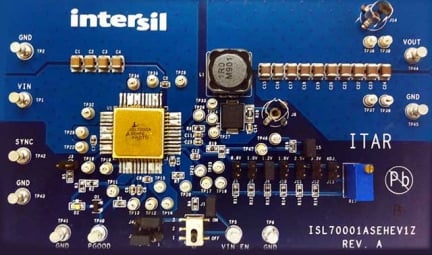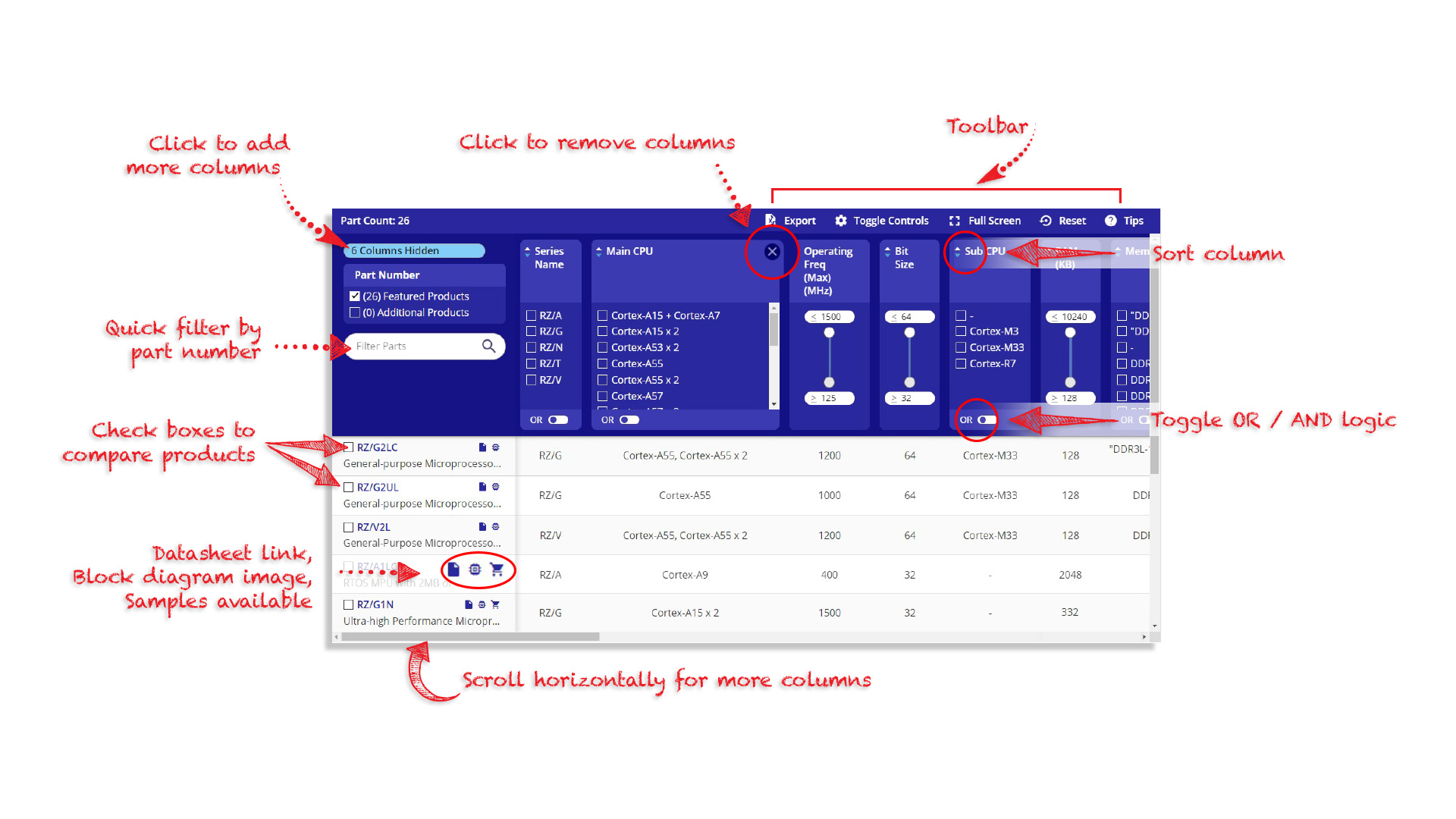Overview
Description
The ISL70001ASEHEV1Z evaluation board is used to evaluate the ISL70001ASEH TID and SEE radiation hardened 6A synchronous buck regulator IC with integrated MOSFETs.
The ISL70001ASEHEV1Z evaluation board accepts a nominal 3V to 5.5V input voltage and provides a regulated output voltage ranging from 0.8V to 85% of the input voltage at output currents ranging from 0A to 6A. The output can be quickly set to any of six commonly used preset voltages (0.8V, 1.0V, 1.2V, 1.8V, 2.5V, 3.3V) or adjusted to an alternate voltage using the onboard potentiometer. A Power-Good (PGOOD) signal goes high and lights a red LED to indicate that the output voltage is within a ±11% typical regulation window. A toggle switch is provided to conveniently enable or disable the output voltage.
Features
- ±1% reference voltage over line, load, temperature and radiation
- Current mode control for excellent dynamic response
- Full mil-temp range operation (TA = -55 °C to +125 °C)
- 50% lower shutdown supply current than the ISL70001SEH
- Available in a thermally enhanced heatsink package - R48.B
- Highly efficient: 94% peak efficiency
- Operates from 3V to 5.5V supply
- Adjustable output voltage
Applications
Applications
- FPGA, CPLD, DSP, CPU Core or I/O voltages
- Low-voltage, high-density distributed power systems
Documentation
|
|
|
|
|---|---|---|
| Type | Title | Date |
| Manual - Development Tools | PDF 498 KB | |
| Datasheet | PDF 1.59 MB | |
| Report | PDF 448 KB | |
| Report | PDF 2.92 MB | |
| Report | PDF 437 KB | |
5 items
|
||
Videos & Training
16 of Intersil radiation-hardened ICs were onboard the December 5, 2014 maiden voyage of NASA's Orion spacecraft, also known as the uncrewed Exploration Flight Test 1. These rad-hard ICs are deployed in Orion's crew module, where they are used to support subsystems for mission critical applications in power distribution, navigation and flight control, and in the inertial measurement unit.
Transcript
3, 2, 1, and liftoff!
Philip: 16 of the Intersil radiation hardened ICs were onboard the maiden voyage of NASA's Orion spacecraft. The Orion spacecraft is designed to go where no man has gone before. Exploring and collecting asteroid samples, a future planned robotic mission to redirect an asteroid, and a long sought-after manned mission to Mars.
So, the Intersil radiation hard electronics are contained within the crew module of the Orion program. This is where the astronauts are going to, you know, live and sleep during deep space. So, reliability is critical. The longer you're in space, the more radiation challenges that you have. Whether that is total dose accumulation from being out for a longer period of time to being able to withstand single event effects of greater energy levels. And in particular on a mission like Orion where you're going to Mars, it's a three-year mission, and you have human lives involved, things have to work. You can't just fly back home. And you don't have a local hardware store that you can go pick up a spare part.
Josh: Intersil has a heritage going back to the 1950s in serving this market. The prime and subcontractors of the Orion program design in a diverse set of Intersil radiation tolerance products, such as our power management and precision analog products. Like the voltage references, voltage regulators, comparators, and multiplexers. These products are used in subsystems such as power distribution, navigation and flight control, and inertial measurement units.
Philip: Intersil solutions have been tested to the highest levels of quality, both from the radiation perspective and from the durability perspective.
Jay: The difference between a commercially tested part and one that's tested for a space customer is significant. In the case of the spacecraft, there's no atmosphere, parts have to be able to withstand extreme temperatures. So the parts are subjected to those temperatures in our testing. Additional testing that we use are the bond pull test. The wires that lead from the integrated circuit to the leads that are going to be part of the package, each lead has to be tested. And every wire has to be pulled, and it must pass.
So 64 leads, 300 units, so we're talking 19,000 wire pulls. The other parts of the environment of course are radiation, we have a low dose radiation facility here on site. They see radiation as equivalent to what the device would see in outer space. We put the parts into a radiator and radiate them for 77 days, so we know before we ever put integrated circuit into a package that that integrated circuit will function in outer space.
Philip: Intersil involvement in NASA has been for the last six decades. What makes Intersil very unique in the radiation hardened electronic industry is we have the capability from design to manufacturing to full radiation testing, all in a single location.
Jay: We have a lot of pride in the devices that we're building and knowing that it's gonna be part of the manned capsule that eventually will put people on Mars. That's really exciting.
Josh: We are always humbled and proud, if you will, of being chosen on various programs and especially a program like this. Individual astronauts that are going to be flying in Orion are absolutely dependent on each individual component doing what it's supposed to do. I'm very proud that we were chosen for this mission.

